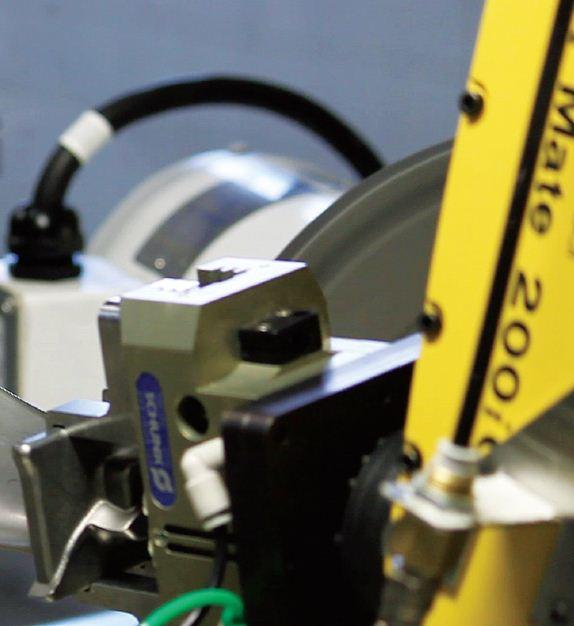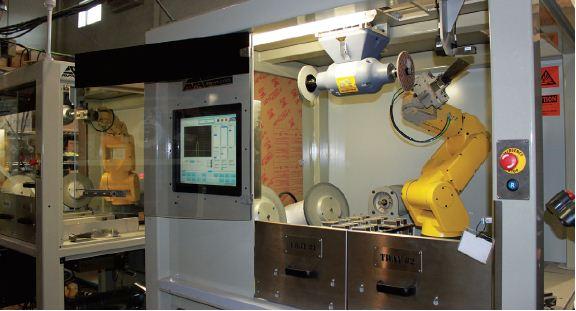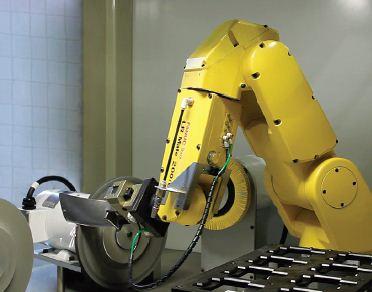- FMA
- The Fabricator
- FABTECH
- Canadian Metalworking
Automating jet engine blade finishing
With heightened tolerances in aerospace design, manual finishing doesn’t make the grade.
- By Canadian Metalworking
- January 29, 2015
- Article
- Automation and Software
Manufacturing parts for today’s modern jet engines requires working to very tight tolerances, and while manual grinding and hand finishing operations were accepted practices in the past, the introduction of more technical designs to improve fuel efficiency in the engines is demanding more precise computer-controlled, automated and repeatable finishing solutions.
Montreal-based AV&R Aerospace is a niche company specializing in automated visual inspection and robotic finishing systems.
Formerly called AV&R Vision and Robotics, the company developed its first automated robotic finishing system in 1997, and it was in 2010 that AV&R Aerospace set its focus specifically on the aerospace industry.
“We went after aerospace because there are a lot of critical components with high value, and there are still a lot of hand finishing operations happening,” says Michael Muldoon, sales and marketing director with AV&R Aerospace.
Muldoon has been with the company eight years, and over that time has observed the advancements being made in aerospace, specifically by the engine manufacturers and the push to high efficiency.
“We’ve positioned ourselves in the market to be able to target these complex processes and offer a solution that allows manufacturers to achieve the larger scale automation they’re looking for in order to achieve the volume they require.”
AV&R Aerospace’s automated finishing approach uses Fanuc robotics, and the main processes include profiling, polishing, deburring and blending. While every application is different, Muldoon claims robotic finishing can result in savings of between 30 to 75 per cent on abrasive costs.
“What we found is, the more a hand finisher works on a part the more waste that goes into the process. As soon as an abrasive becomes less effective the operator is going to change out his pad or belt and start with a fresh one.”
AV&R Aerospace has performed testing to evaluate abrasive life and programmed the parameters into its system so it’s able to maximize the abrasive use. Besides the cost savings inherent in automating a process with robotics, the necessity of high precision machining required by the aerospace industry is really leading the move to programmable, repeatable robotic finishing.
Profiling of compressor blades in jet engines is becoming a very precise science, as the shape on the leading and trailing edge of the blades has an impact on the their performance in the compressor, ultimately effecting overall engine efficiency.
The timing of AV&R Aerospace’s introduction of its automated blade leading and trailing edge profiling system has coincided well with the industry’s push towards more efficient engine design programs, notes Muldoon.
He cites the Bombardier C Series for example and their target of achieving 15 per cent fuel savings over previous generations. “One of the interesting things we found is these operations [compressor blade profiling] used to be done by hand, but in order to achieve these performance targets they’ve had to tighten all of the tolerances, so no longer are they able to do it by hand.”
He goes on to explain that when it comes to profiling compressor blades, the old tolerances specified only a round even edge, so in those cases alternative finishing techniques, like tumbling for example, were often able to achieve the results.
But new designs have changed the process. “Now manufacturers want a specific elliptical shape and typical tolerances are plus/minus 1-1/2 thousandths, or 37-microns, and because you need a specific shape, tumbling’s out of the question,” says Muldoon.
According to Muldoon most of the OEMs have standardized on automated profiling in order to achieve the engineering tolerances they’ve designed into their products.
AV&R Aerospace’s profiling system is an adaptive closed-loop system, taking a forged blade and putting a leading edge shape on it with the specific customer-design angle.
“We start from the customer’s 3D model of the part,” explains Muldoon. “They’ll have specifications at different sections for the specific edge shape. Using laser sensors we’ll measure the forged part at those positions, and we’ll create a routine in real time based on that feedback, and this is all programmed in the robot. The robot then calculates the path it needs to perform in order to create the required edge shape.”
Once a cycle is complete, a final leading and trailing edge inspection can be completed, and the profile is adjusted or the part is removed and the next one is brought in.
“There are other robotic finishing companies in North America and a couple in Europe, but our combination of the inspection and measurement with the robotic finishing is unique,” says Muldoon.
Besides new part finishing, Muldoon sees a place for AV&R Aerospace’s profiling system in the aerospace maintenance, repair and overhaul (MRO) market as well.
After a set amount of flight hours engines require an overhaul. According to reports from Lufthansa Technik, the maintenance and overhaul services division of Lufthansa Group, dust particles entering with the airflow cause erosion at the leading edges of compressor blades in jet engines, leading to a deterioration of the engine efficiency. In 1994 Lufthansa Technik developed a procedure for analyzing worn blades electronically and then began re-contouring them with its own automated robot. The results led to improved fuel consumption and also extended the life of the components.
With AV&R Aerospace’s profiling system, they are able to import the original specs for the compression blades, inspect the existing part and with its adaptive capability the system will determine an optimized profile to get the blade back to spec.
“The big thing with profiling is the fact that you can’t hit the tolerances by hand anymore,” says Muldoon. “If you want to manufacture these parts and you want to be involved in these new engine programs, well you need to have the equipment to get on board.”
About the Author
subscribe now


Keep up to date with the latest news, events, and technology for all things metal from our pair of monthly magazines written specifically for Canadian manufacturers!
Start Your Free Subscription- Trending Articles
Aluminum MIG welding wire upgraded with a proprietary and patented surface treatment technology

Achieving success with mechanized plasma cutting

Hypertherm Associates partners with Rapyuta Robotics

Gema welcomes controller

Brushless copper tubing cutter adjusts to ODs up to 2-1/8 in.

- Industry Events
MME Winnipeg
- April 30, 2024
- Winnipeg, ON Canada
CTMA Economic Uncertainty: Helping You Navigate Windsor Seminar
- April 30, 2024
- Windsor, ON Canada
CTMA Economic Uncertainty: Helping You Navigate Kitchener Seminar
- May 2, 2024
- Kitchener, ON Canada
Automate 2024
- May 6 - 9, 2024
- Chicago, IL
ANCA Open House
- May 7 - 8, 2024
- Wixom, MI


















